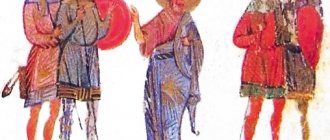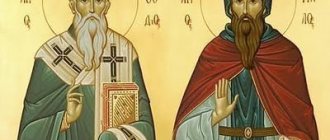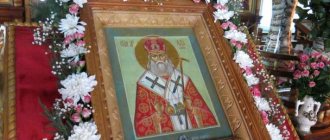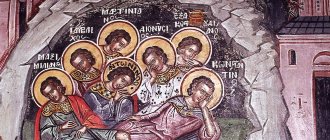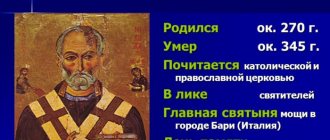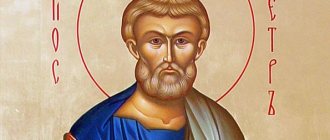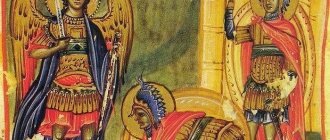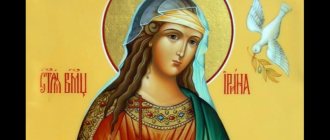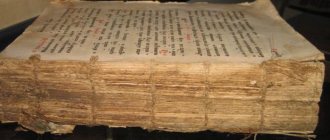Some saints in the Orthodox calendar never existed, or their existence was so distorted and fictitious that they are no longer recognizable. Among them is the martyr Christopher, who is depicted on the icons in a rather unusual image.
This saint is traditionally depicted with the head of a dog or horse. It is practically unknown to Orthodox Christians, as it is quite rare. Was there ever a real Christopher under any name, with or without a dog's head?
Icon of an unknown icon painter, 17th century
Story
According to Eastern tradition, this saint lived in the third century and his name was Reprev. He came from the region of Marmarik, in the Libyan Desert. In one of the battles he was captured by Roman soldiers. After this, he served with the Romans in a special unit consisting only of Berbers. This man was of enormous stature and terrifying behavior, he was cynocephalous (with a dog's head), like all representatives of his tribe.
According to another legend that appeared in Cyprus, the saint was very handsome. Wanting to avoid temptations and women who bothered him, Christopher prayed to God, who, in response to this prayer, replaced his head with a dog’s.
The first option is, of course, more likely. Apparently, he was very scary, which is why they associated him with a dog.
Like most saints of that time, Christopher preached successfully, for which he paid with his life. The emperor ordered the martyr to be thrown into a red-hot copper box. However, the saint did not experience suffering and remained unharmed. After many cruel tortures, the martyr's head was finally cut off with a sword.
In Western Christianity
In Western Christian iconography, the saint, whose name literally translates as “Christ-Bearer,” is depicted as a giant carrying the Christ Child on his shoulders. In the “Golden Legend” - a set of lives of the 13th century, compiled by the Dominican monk Jacob of Voraginsky, it is said that Christopher - then still bearing a different name - worked at a river crossing. When he once carried a child across the river, he felt an unbearable weight, as if holding the whole world. It turned out that the giant carries not only the world, but also the One who created it. Christ himself appeared to Christopher in the form of a child.
The golden legend says:
The third time he was called, he came there and found the child by the river, which begged him kindly to carry him over the water. And then Christopher lifted the child onto his shoulders, took the staff and entered the river to pass.
And the water of the river rose and swelled more and more; and the child was as heavy as lead, and as he went on, the water grew larger and larger, and the child became heavier and heavier, so that Christopher was in great pain and was afraid of drowning.
And when he escaped with great difficulty, and passed by the water, and put the child aground, he said to the child: Child, you expose me to great danger; you weigh almost as much as the whole world on me, I couldn't bear a greater burden. And the child answered: Christopher, do not be surprised at anything, for you not only carried the whole world on yourself, but you also carried on your shoulders the one who created and created the whole world.
I am Jesus Christ the King whom you serve in this work. And since you know that I speak the truth, lay your staff on the ground near your house, and you will see tomorrow that it will bear flowers and fruits, and soon it will disappear from his sight. And then Christopher put his staff into the ground, and when he rose in the morning, he found his staff like Palmyra, bearing flowers and leaves and dates.
The tradition of depicting Christopher as a tall man with a baby in Western medieval sculpture, book miniatures, as well as painting of later times is stable.
Martyr Christopher
Before his baptism, his name was Reprev; he lived at the turn of the 3rd–4th centuries in North Africa, which at that time was part of the Roman Empire. He was a strong and tall man and served in the imperial army. Before going against the Goths, Emperor Decius demanded that the soldiers sacrifice to idols, but Christopher refused, declaring himself a Christian. For this he was tortured and then beheaded.
In the Western tradition there is a legend that before his baptism, Christopher began to seek the most powerful God. He went to the king, but he was afraid of demons. I studied demonology, but the demons were afraid of Christ. And he found Christ in the form of a Boy who asked to be carried across the river. In the middle of the ford, the mighty Reprev realized that the Boy had become incredibly heavy. At that moment Christ revealed himself to him, saying: “Go, with My help you will definitely cross.” And after that he became invisible.
Saint Christopher. Hieronymus Bosch
Christopher means “bearer of Christ.” The name echoes the legend about the appearance of Christ to Christopher in the form of a boy, whom the saint carried across the river. This plot was depicted by many great artists: Bosch, Memling, Witz and others.
In Eastern Orthodoxy
In Orthodoxy, Christopher is often depicted as dog-headed. At the same time, it is indicated that this appearance, like the origin of the saint from the country of the Cynocephalians, should be understood as a symbolic indication of his rudeness and ferocity during his period as a pagan.
The earliest surviving Eastern Orthodox example of an icon of Christopher's dog's head appears to be this ceramic image with Latin inscriptions from Macedonia, depicting him with St. George slaying the serpent.
In Russian icon painting, images of St. Christopher with a dog's head have been known since the second half of the 16th century. In Russia, Christopher's head sometimes looks more like a horse's than a dog's.
An ancient manual of Russian painters describes how it should be painted:
And the holy martyr Christopher: a dog's head, in armor, a cross in his hand, and a sheathed sword in the other; outerwear cinnabar with white, under green.
Elsewhere it is written:
Christopher: a young man, like Demetrius of Thessaloniki, carmine clothes, under green, in his hand a scroll: “Lord Almighty, where my memory is honored and praise is to You, save them from sin and do not judge them.”
Memory and veneration of the Saint
The Saint's Day of Remembrance in Orthodoxy is celebrated on May 9.
Saint Christopher's Day of Remembrance in Catholicism is celebrated as a locally revered holiday, since the Catholic Church considers evidence of his exploits insufficient. Many documents, including testimonies from contemporaries, were lost after the conquest of the region by the Arabs and Turks. But Christopher was not decanonized and remains a Saint of the Catholic Church.
Interesting! The Saint is especially revered in Spain. There they name settlements in his honor and ask him for protection and healing from diseases. In Spain, the Saint is considered the patron saint of motorists, bridge builders and gardeners.
Saint Christopher is the patron saint of nine cities, including the capital of Lithuania.
Where did the dog's head come from?
Versions of the composition of such an exotic iconography of Christopher the Cynocephalus (dog head) are mainly associated with the assumption that some of his nicknames were interpreted erroneously.
Nickname options
- From the geographical name: the area of Cynoscephalia is a hill in Thessaly.
- From the word "cananeus" ("Chananite"), which could be interpreted as "dog-like".
- The description of his terrible appearance—“beast-like”—could be taken literally.
- Another option: comparison with the symbol of fidelity - the dog - gradually developed into combining the image with the symbol. Parallels are drawn with the guardsmen of Ivan the Terrible (indeed, each of them was a “horseman with a dog’s head”), etc.
Another version says that the image of the dog-headed man came from Coptic Christian painting, on the territory of which traces of the veneration of the dog-headed Anubis remained.
Anubis: Vatican Museum, Rome
There is also an idea of Christopher as a representative of the tribe of “dog heads” - dog-headed people, descriptions of which have been found quite often since ancient times.
Origin and appearance of Christopher Pseglavets
There is still no agreement among historians about the place and date of birth of Christopher. According to some sources, Christopher was born in the land of the Canaanites. Canaan is an ancient state on whose territory the city of Jerusalem arose. The Canaanites are the first inhabitants of this land. Before the adoption of Christianity, the Saint bore the name Reprev, which means “Rejected.” According to others, he came from a family of cynocephali - people with dog heads.
Interesting to know! Cynocephals are characters found in the culture of different countries. They are a creature with the body of a man and the head of a wolf or dog. Descriptions of dog-headed people are often found in ancient literature.
Historians and theologians still argue today whether the Saint actually had a dog's head.
According to some evidence, Christopher had this appearance from birth. According to other, later sources, Christopher was a very handsome young man, his appearance seduced many women. Then the Saint began to ask God to give him an ugly appearance, since he did not want to be the involuntary cause of the sins of others. After this, the man’s face became like a dog’s. Saint Christopher the Pseglavets It is not ruled out by historians that the image of a man with a dog’s head could be metaphorical. He speaks of the rudeness and ferocity of Christopher in the days when he was a pagan. In moments of rage, his face distorted and became ugly, the man was likened to a beast. Many sources do not say about the head of the animal, they only say that the Saint had an ugly face. Perhaps there is a genetic pathology exaggerated by the storytellers. Evidence of the bestial appearance was given by the Saint’s contemporaries. Later generations could take the hyperbole for a real fact. According to another version, dog-headed means barbarian. It is possible that Christopher was a barbarian and a Roman mercenary until the day he began his spiritual path as a righteous man. Interesting! Apostle Andrew visited the lands of Pakistan, where the Cynocephalic tribe lived. They deliberately disfigured themselves to intimidate their enemies. The babies' skulls were compressed so that they took on an elongated shape. The warriors cut their cheeks to their ears and sharpened their teeth.
After defeating their enemies, kinocephals drank blood from their wounds. Perhaps the Saint previously belonged to this tribe, which is why he had such a specific appearance.
Prohibition of the image of a dog's head
The icons of Christopher “with the head of a dog,” along with some other “controversial” iconographic subjects, were officially prohibited by order of the Synod of 1722 as “contrary to nature, history and the truth itself.”
Since the 18th century Christopher is depicted only in human form. After the ban, he began to be depicted dressed like a Roman soldier.
There are known transcribed images with a dog's head recorded. The Old Believers continued (and still continue) to venerate Christopher Cynocephalus, and the ban on the “dominant church” only confirmed and strengthened this veneration. The Sviyazhsk icon painting tradition depicts Christopher not with a dog’s head, but with a horse’s head.
Most of the ancient images of the dog-headed Christopher were destroyed or written down. In addition to the fresco in the Assumption Monastery in the city of Sviyazhsk, there is a fresco in the Makaryevsky Monastery, as well as in Yaroslavl in the Spassky Monastery.
Icons of Christopher have been preserved in Cherepovets (art museum), in Rostov, as well as in Perm, Yegoryevsk History and Art Museum.
The icon of St. Christopher with a dog's head can be seen in the Moscow Old Believer Church of the Intercession, the Moscow Kremlin (Archangel Cathedral), in the Yaroslavl Sretensky Church, in the Tretyakov Gallery. Sculptures have also been preserved. One of them is kept in Notre-Dame Cathedral in Paris. Most of these icons were destroyed during the period of iconoclasm.
Forgotten Reality
One of the most significant and most silent figures in Christianity is Saint Christopher.
.
The fact is that he has a dog’s head, and in the 17th and 18th centuries (in Russia - in 1722) all his images in churches were scraped off and painted over. Here are his three incarnations: one in the guise of a dog with a cross, the second - the half-beast, half-man Reprev with a cane that turns green with leaves, and the third in the guise of a man named Christopher, that is, the Bearer of Christ (the baby).
So who is Christopher really?
Due to his main function as a carrier across the river, the wonderworker Christopher, aka Offero, aka Reprev from the land of cannibals, must be Charon
, a Greek deity standing at the crossing to hell, at the river of oblivion called Styx. It is not for nothing that in one of the legends the emperor cannot kill Christopher. How can you kill someone who goes to the next world every day?
In the later version, Charon is already the owner of his own boat, but this does not change the essence. This same Charon-Offero-Reprev carried the baby Jesus across a certain river, and here we should remember the descent of Christ into hell, and in Greek legends hell is located just beyond the river. According to legend, Jesus was heavy - even in the form of a baby - the Chief Carrier could barely carry him on himself. And he acknowledged Him as Lord and bowed his knees.
It is clear that the admiration of such an important being as Charon is worth a lot, this is the act of surrender of Death to Christ. By depicting on the icons the process of Jesus' return on the shoulders of Christopher across the river of oblivion, the church, in essence, demonstrates that the act has been signed.
But Christopher has another twin image - the Egyptian Anubis
, the god of death and rebirth of all living things, is essentially a normal peasant god of spring. Anubis is also a dog-headed man, and most importantly, in his hands, just like Christopher’s, is a flowering staff. This is the victory of spring over winter, and life over death, which all farmers observe every year. Grain - dry and dead, being buried in damp earth, is resurrected in the same way as the staff of Anubis, or like the staff of Reprev, Offero or Christopher. These allegories are extremely closely connected with the idea of the Resurrection of Jesus.
It remains to be seen what dogs have to do with it, and the answer cannot be found in Eurasia: the dog is tabooed by the largest religions, as one of the forms of the Evil One. The answer was preserved by the Aztecs. From their point of view, a dog is an excellent guide to the next world, and while the soul that has flown out of the body trembles, not understanding what to do, the dog leads it exactly to the cave of its ancestors. Therefore, the Indians always killed and buried a dog.
The common roots of cultures are especially clearly visible here. Under the guise of the civilized Christopher lies a slightly more ancient Charon, then an even more ancient Anubis*, and if you scratch more intensely, an ordinary Indian dog begins to appear, which was placed in the grave of every departed relative.
* In Christianity, the day of veneration of Christopher the Pseglavets is July 25 - a day “out of time” according to the Mayan calendar, the day of transition from one time period to another, the beginning of the New Year, in fact, the Gate of Transition. In Egypt, the guardian of such Gates of Transition is... Anubis.
The head of Christopher, by the way, is kept in one of the churches in France. In the event that this head is a dog’s, the relic must be old, before the reform of the 17-18 centuries.
Anubis (left) and Christopher (right)
About the righteous dogs
All “real” churches were well aware of the sacred meaning of the dog. The Dominicans (Domini canis - dogs of the Lord) tattooed a dog's head with a torch in its teeth on their wrists - at least that's what they think. In the dog’s teeth there was a blossoming spring branch - a symbol of resurrection, a symbol of new life that awakens in the hands of Anubis every spring, and in the Church of Jesus - every Palm Sunday.
The guardsmen have the same symbolism: a dog’s head and a broom – in fact, a bunch, a bundle of twigs with leaves, and at the same time a symbol of unity. And there is no need to be surprised that a giaur and a Christian are synonymous, and dog-knights are just dogs. I think the term “cop” did not arise out of nowhere. At least, the patron saint of people with risky professions, including police officers, is the dog-headed Christopher.
Saint Christopher the Pseglavets. The mystery of the image and details of life
On Sunday, May 22, the Church honors the memory of St. Martyr Christopher. Statistics show that among visitors to Rogozhskaya Sloboda and guests of our site there are many who are interested in the history of this saint and his unusual image, undeservedly forgotten by the Synodal Church along with many ancient customs, rules and practices. We share our own research on the topic.
In the sacristy of the Intercession Cathedral of Rogozhskaya Sloboda there is an amazing icon of the holy martyr Christopher, traditionally depicted with the head of a dog or horse. The image of the saint is so interesting, multifaceted and at the same time unusual that it invariably gives rise to a lot of questions regarding its origin.
This icon was included in the illustrated encyclopedia “Antiquities and Spiritual Shrines of the Old Believers” as one of the pearls of the Rogozhsky sacristy. We present for readers of Old Believer Thought a detailed study of the origin of the tradition of depicting the saint in this way, fortunately, in the Synodal Church after Nikon’s reforms, the image came under an unmotivated ban.
ROGOZH SACRY Holy Martyr Christopher. Vetka. End of the 18th century Wood, gesso, tempera. 44.9x37.6 cm. On the back there is an inscription in cinnabar: “To the house of Alexander Dimi/Triev Shyshkin.”
The martyr Christopher is represented with a dog-headed figure, waist-deep, turning to the left. On his left shoulder is a thin red spear, which he holds with his left hand, his right hand is raised with two fingers. Human eyes look at the viewer, brown hair falls in long curls over the shoulders. The armor, the cloak clasp and the spear tip are gold, with a niello pattern on the same gold sheet, which also covers the saint’s halo, the background and the margins of the icon. The personal letter is executed using the usual sankir technique: a lighter reddish ocher is placed on a light brown base, followed by highlights. As a result, a dark skin color is conveyed. The master manages to give the animal’s mask a blissful, touching and trusting expression. In the design of fabrics there is a noticeable dependence on the style of Baroque and Rococo. On the cloak, the pattern and shading of the folds are brown-crimson, the final highlights are made using a gold-white technique. At the top of the middle there is the inscription: “S(Y)THY MU(SCHILNIK) CHRISTOPHOR.”
The coloring of the icon is based on a combination of the crimson tone of the cloak with the blue tone of the saint’s shirt and with the brown tone of the personal one. Dense yellow gold serves to unite them and create conventional depth. The master's work with color, techniques for modeling the form, as well as the color and rhythm of the stripes that frame the centerpiece and the entire icon are characteristic of Vetka icon painting of the late 18th century. // V.M. Forty.
Rare shot
At the entrance to the Intercession Church there is another practically unknown icon with the image of St. Christopher.
A large icon at the entrance to the Intercession Cathedral with the image of St. martyr Christopher among the martyrs. The Holy Martyr Christopher is depicted among the martyrs
The last compelling argument for organizing the study was a letter from a reader of the STAROVE.RU website:
Good evening! Today I was in the church utensils and icons store “Sofrino” of the Russian Orthodox Church MP. I wanted to order an image of the martyr Christopher from ancient writing (with a dog's head). They tell me: “The image is not canonical. Banned by the Holy Synod in the 18th century. Not everything on the Internet is correct. The true image is this…” (and they show me on their computer the martyr Christopher in the image of a man carrying the Infant of God on his shoulders). I answer: “The Council of 1971 abolished all oaths on the old rituals, canons, icons and lifted the anathemas from the Old Believers. A similar spelling of Christopher is still used in many local Orthodox Churches.” They answer me: “This is none of our business. The plant's confessor forbade production. What you want is blasphemy. We don’t know where and how you will order such an icon, or who will make it for you, but only we have the true image.”
Just like that... It was not the oaths that became “as if they had not been”, but the resolutions of the Council of 1971 and all subsequent Councils of the Russian Orthodox Church. We are talking about the store of the art and production enterprise “ Sofrino” of the Russian Orthodox Church MP
.
There are two branded stores in Moscow: 1) on Kropotkinskaya (central); 2) in Sokolniki
(on the territory of the Church of the Resurrection of Christ), where I tried to place an order.
Nikon-Petrovsky “new items” in action: the “corrected” image of St. Martyr Christopher on top of an ancient fresco in Yaroslavl
This note is based on the scientific research of S.K. Chernova – leading specialist of the Cherepovets Museum Association
.
In Cherepovets there is also an image of St. Martyr Christopher Pseglavets, dating back to the 17th century, but this is not the only place where people became interested in the history of the unusual image. Blogger carabaas
shares the history of the appearance of the image of St. Martyr Christopher with a dog's head from the collection of icons of the Rostov Museum:
This icon was originally located in the Rostov Museum, and got there by order of the New Believer Archbishop Jonathan (with whose blessing the museum itself was created in 1883). The background to the appearance of the icon was described in the Diocesan Gazette as follows:
“When reviewing the diocesan churches in August 1880, His Eminence in the church of the village “Bogorodskoye in Oseka” saw, among other things, an icon of the martyr Christopher, the size of a man, with the head of an animal, namely a dog. The Bishop noticed all the indecency in the temple of such an icon and ordered it to be taken out of the temple”...
Christopher is a holy martyr, revered by the Orthodox and Catholic churches, who, according to legend, lived in the 3rd century AD. The life of Saint Christopher, which was distributed in Cyprus and later in Rus', says that the saint was very handsome, but in order to avoid temptation, he begged the Lord to disfigure his appearance. Modern theologians, as well as Rogozhsky old-timers, adhere to this version, emphasizing the original ordinariness of the saint and at the same time “reconciling with the mythologized Russian image of the saint that has taken root over the centuries.” (quote from the Encyclopedia “Myths of the Peoples of the World”. M., 1982. T. 2, P. 604).
Examples of traditional images of St. much Christopher. Eastern tradition of venerating St. martyr Christopher
The legend of the Eastern tradition says (see: Lives of the Saints, in Russian. P. 290; Menaion - May. Part 1, P. 363) that during the reign of Emperor Decius Trajan, a man named Reprev was captured during battle with tribes in eastern Egypt. He was a man of enormous stature, cynocephalic (that is, with a dog’s head), like all representatives of his tribe.
Even before baptism, Reprev confessed faith in Christ and denounced those who persecuted Christians. Emperor Decius sent 200 soldiers for him. Reprev obeyed without resistance. Miracles happened along the way: the rod blossomed in the saint’s hand, and through his prayer the loaves multiplied, just as the Savior multiplied the loaves in the desert.
Saint Christopher. Greek icon. Constantinople
The soldiers accompanying Reprev were amazed by the miracles, believed in Christ and, together with Reprev, were baptized by the Bishop of Antioch, Vavila. After baptism, Reprev received the name “Christopher”. When Christopher was brought to the emperor, he called two female harlots and ordered them to persuade the saint to renounce Christ, but the women, returning to the emperor, declared themselves Christians, for which they were subjected to cruel torture and died as martyrs. Decius sentenced Christopher to execution, and after cruel torture the martyr's head was glassed. (see: Lives of the Saints, in Russian. P. 290). One of the miracle martyrs was that he remained unharmed after the emperor ordered him to be placed in a red-hot copper box.
Saint Christopher. Greek icon. 18 century
In Antioch, the memory of the martyr began to be venerated not immediately after his death, but some time later, so that even his real name was forgotten and was replaced by the honorary title Christophoros. This is quite understandable, since the saint was not a member of the local Church, but was a foreigner who served in a special cohort of the Roman army in Syria. Moreover, Christopher was baptized not by the bishop of Antioch, but by the exiled Alexandrian presbyter Peter, who, after the execution, bought the body of the saint and sent it home. In the art of Byzantium, there were several options for depicting the martyr, which were formed in the early era. The most common image is of a young man dressed in patrician robes (frescoes of Dečan and the Church of St. Clement in Ohrid) or in military armor. The latter option is represented by the paintings of the Old Church (Tokali Kilisse in Goreme, Turkey, X - XI centuries), in the mosaics of the Hosios Loukas Monastery (second quarter of the XI century). In Rus', the image of St. Christopher as a young warrior was preserved in the deacon arch of the Church of St. George in Staraya Ladoga (last quarter of the 12th century).
Western tradition of venerating St. Christopher
Legends about St. Christopher in the Western interpretation are very different from those familiar to us. One of them says that Christopher was a Roman of enormous stature, who originally bore the name Reprev. Other legends say his name was Offero and he was born in Canaan.
Basically, the Catholic tradition is based on the “Golden Legend” of Jacob of Voraginsky: the giant Reprev is looking for the most powerful ruler to enter his service. He enters the service of the king, but finds out that he is afraid of the devil. He offers his services to the devil, but understands that he trembles at the sight of the Cross.
The giant Reprev-Offero finds the holy hermit and asks him how he could serve Christ. The hermit takes him to a dangerous ford across a river and tells him that his great height and strength make him an excellent candidate to help people cross the dangerous water.
Catholic version of the life of St. Christopher
He begins to carry travelers on his back. One day a little boy asked him to carry him across the river. In the middle of the river, the boy became so heavy that Christopher was afraid that they would both drown. But the boy told him that he was Christ and carried with him all the burdens of the world. Then Jesus baptized Reprev in the river, and he received a new name - Christopher, “carrying Christ.” The Child then told Christopher that he could stick a branch into the ground, which miraculously grew into a fruitful tree. This miracle converted many to faith. Angered by this, the local ruler (in Western tradition he goes by the name Dagnus) imprisoned Christopher, where, after much torment, he suffered a martyr's death.
The legend is based on two paradoxes that balance each other: the powerful ruler whom Christopher serves turns out to be a Baby, the embodiment of weakness and defenselessness; on the other hand, this baby is weightier and more significant than the entire Universe.
Since the 12th century, this plot has had a huge influence on Western iconography, which invariably depicts Christopher with the infant Christ at the moment of crossing the river. This legend of St. Christopher carrying the Christ Child across the river may have originated around the 6th century. In the middle of the 9th century it spread throughout France.
Reliquary with the head of Saint Christopher. Croatia. Rab Island Mary's Church
Christopher's Day was demoted to a local holiday by the Vatican in 1969 due to a lack of tangible evidence of its existence. But contrary to popular belief, Christopher was not decanonized, like, for example, the “saint” Valentine known to many lovers: he still remains a saint of the Catholic Church. See article and comments.
Although the surviving evidence of his life is intertwined with stories of miracles and phenomena that are poorly accepted by modern historiography, enough information has survived to attempt to paint a picture of his life acceptable to modern people.
Saint Christopher. Greek icon
Firstly, it is undeniable to mention that evidence of Christopher as a dog-headed man was given by his contemporaries. For people of that era (we are talking about Greco-Roman-Persian territories), the practice of describing all people from the “uncivilized” world as cannibals, with animal body parts, was very common, although at first it was used metaphorically. Later generations may have accepted this metaphor and hyperbole as fact.
Stories about dog-headed people were often found in travel stories in antiquity and the Middle Ages, starting with Herodotus’ description of Scythia. Marco Polo, for example, already in the 13th century met cynocephals in his Indian travels: “All the people of this island have heads like dogs, I assure you that all the details of their faces are the same as those of large mastiffs...”. Written from the words of the Italian traveler Marco Polo, “The Book” (1298) is one of the first sources of European knowledge about the countries of Central, East and South Asia.
The veneration of the saint in both the Western and Eastern traditions is so popular (this popularity is growing today) that the personality of the saint, extremely unlike all other saints, direct references to the history of Ancient Egypt with its zoolatric mythology, force researchers to turn again and again to the problem of the origin and existence of the image of St. Christopher.
Veneration of St. Christopher in Orthodoxy
Icon from the Yegoryevsk History and Art Museum
In Orthodoxy, Christopher is often depicted as dog-headed. Versions of the composition of such an exotic iconography of Christopher Cynocephalus are mainly associated with the assumption that some of his nicknames were interpreted erroneously. There are several options for the origin of the nickname “cynocephalus”.
Perhaps this is a distorted name for the geographical name of the area where Christopher was supposedly from - Cynoscephalia (a hill in Thessaly). Also, the word “Canaanite” (originally from Canaan) is close in sound to the Latin word for “dog.”
The description of the terrible appearance - “bestial” could be taken literally by the translators. Another version: a comparison with a symbol of fidelity - a dog - gradually developed into combining an image with a symbol (Ivan the Terrible’s guardsmen attached a dog’s head to a horse’s saddle, it turns out that each of them was a “horseman with a dog’s head.”
It can also be assumed that the image of the psoglavets came from Coptic Christian painting. In Egypt there were still traces of the veneration of the dog-headed Anubis, although not all researchers find it appropriate to draw such temporal or geographical parallels.
Version of borrowing an ancient Egyptian image
In Egyptian mythology, there was a god - the patron god of the dead, Anubis (Inpu). He was revered in the form of a lying black jackal or a wild dog Sab (or in the form of a man with the head of a jackal or a dog). According to the Pyramid Texts, Anubis was the main god in the kingdom of the dead, he counted the hearts of the dead. (see: Korostovtsev M.A. Religion of Ancient Egypt. M., 1976, P. 260)
An unnamed guess says that the Copts (Egyptians) could transfer memories of their god Anubis into Christianity. It also says that the iconographic image of a saint with a dog’s head disappeared almost everywhere in the West and East by the era of the Reformation. On the other hand, it is known that in the West in general icon painting is extremely rare; the legend was replaced by the “Golden Legend” of Jacob Voraginsky. Well, in the East, in particular in Rus', by the 17th century the image of St. martyr Christopher was extremely common in various versions, which casts doubt on the Egyptian version. Only after the reforms of Patriarch Nikon did the Synodal Church begin to massively destroy the “unseemly” image of the saint.
However, the Coptic Church depicted saints with dog heads as early as the 18th century. An icon from the Museum of Coptic Art in Cairo depicts Saints Ahrax and Aughani, who also have dog heads. Perhaps icons of such images helped ancient preachers find a common language with the dark pagan population of the distant provinces of the Roman Empire. On the other hand, there is no veneration of Christopher in Egypt at all, and there is also no connection between the jackal-headed god of the dead, an expert in embalming, and the martyr for Christ, a warrior, an assistant in illness and travel.
Saints Christopher and George slaying snakes. Terracotta. Vinika. Macedonia. 6-7 centuries
The oldest known image of Pseglavets is represented on a miniature ceramic icon of the 6th-7th centuries from Macedonia. Saint Christopher, together with Saint George, slays the snakes. Both martyrs are depicted with spears, between them there is a round shield and a cross. Another image of the saint with a dog's head, but no longer in military garb, is in the Byzantine Museum in Athens.
Image of St. Christopher in Rus'
Despite the fact that in the Iconographic Original of the 16th century, the Novgorod edition of Saint Christopher says that he is depicted in the image of a young warrior, in Russian art of the second half of the 16th century and in the 17th century, icons of Christopher with the head of a dog became widespread. (see: Snegireva E.A. The Image of St. Christopher..., P. 55)
The first mentions of the saint’s memorial days are found in month books of the 11th-12th centuries. Perhaps the saint was revered as a protector against infectious diseases and epidemics. Thus, in Veliky Novgorod in 1553, a church was built in the name of St. Christopher precisely during the pestilence.
Saint Christopher and the Yaroslavl Wonderworkers. Russian icon. 18 century. State Historical Museum
In 1551, during the reign of Ivan the Terrible, the Sviyazhsk fort was built and an Orthodox church in it, the main icon of which was the image of St. Christopher the Pseglavets. The head can be mistaken for a wolf, a dog, or a horse. The Sviyazhsk image is one of the few that were not rewritten in the accepted Orthodox canon after the death of Tsar Ivan Vasilyevich.
During the life of Ivan the Terrible, icons of Christopher the warrior with a dog, wolf or horse head were in hundreds of churches throughout the Muscovite kingdom. The special historical role of Sviyazhsk lies in the fact that the city was built as a base for the conquest of the Kazan Khanate and the development of the richest steppe expanses of the Volga region. It is known that on the site where the city was built, before that, back in the 13th century, there was a large pagan temple.
Saint Christopher. Icon. XVIII century State Museum of the History of Religion, St. Petersburg
At least 60 thousand Tatar cavalry took part in the assault on Kazan. About 30 thousand of them were brought by the Tatar aristocrats of the Kasimov kingdom, and about 20 thousand were young Astrakhan princes, dissatisfied with their authorities.
The time of Ivan the Terrible was a time of mass conversion of the Tatar nobility to Orthodoxy. This probably explains the oddities in the image of St. Christopher. His head was supposed to calm the conscience of the steppe princes in front of the memory of their ancestors and totem animals - the wolf, horse, dog. When the process of transition to Orthodoxy and the Russification of the Tatar khans was basically completed, the need for such a serious violation of the canons of Orthodoxy disappeared, and the heads of St. Christopher on almost all icons were rewritten.
A modern image of St. Christopher, created under the influence of Catholic legends
Officially, the icons of Christopher “with the head of a dog,” along with some other “controversial” iconographic subjects, were prohibited by order of the Synod of 1722, but the Senate did not support the decision of the Synod, recommending not to take unambiguous measures regarding those images that were already widely admired by the people. In the mid-18th century, the clergy, including Metropolitan Arseny (Matsievich), advocated the correction of icons of the saint. In response to the Metropolitan’s petition to ban the icons of Cynocephalus, a special case was opened at the Synod, but it did not receive further development. (see: Snegireva E.A. The Image of St. Christopher..., P. 56)
Apparently, decisions regarding images of the saint were made at the discretion of the local church authorities. In some cases, the icons of St. Christopher were indeed corrected. In the painting of the Transfiguration Cathedral in Yaroslavl, the dog head of the saint depicted on the pillar was replaced by a human one. Traces of the existence of the former image of the saint can still be seen: on the right side of the halo the outline of a dog’s face is visible.
Another example from the Rostov region is given by blogger carabaas
, deliberately emphasizing with his remarks the disdain for antiquity ingrained in Nikonianism:
The New Believer Saint Demetrius of Rostov could with good reason write the following: “The unreasonable icon painters are in the habit of writing absurdly, like St. Martyr Christopher with his dog’s head, which is a fable” (“Search for the Bryn Faith”). The words of the saint primarily denounce the Old Believers who are trying to freeze church tradition, including at the expense of common sense. The image of the martyr Christopher with the head of a dog is still one of the essential signs of “ancient” piety for them.
Old Believer hagiographic icon of St. Christopher.
In the 18th century, secular authorities also took upon themselves to restore order in icon painting. In 1722, Emperor Peter, in the presence of the Synod and the Senate, declared his will to correct the icons in accordance with the resolutions of the Council of 1667. By order of the Synod, an extract from the council decisions on the icon of Hosts was prepared, which was supplemented with a list of images contrary to “nature, history and the truth itself.” “, which included the image of the martyr Christopher “with the head of a dog” and some others. A modern researcher writes that “no detailed justification for this decision was given, but evidence of theological and aesthetic sobriety is evident here” (N.K. Gavryushin, preface to the collection “Philosophy of Russian Religious Art of the 16th-20th centuries. Anthology.”, M. , 1993).
Saint Christopher with a wolf's head. Popular picture.
Citing a self-incriminating quote about the absence of grounds for replacing the old with a new carabaas
in an article signed by
“Priest Roman,”
he continues his attack on Old Believer conventions, indiscriminately calling ancient iconography
“erroneous”
:
In the Rostov diocese, the most active eradicator of erroneous tradition was St. Arseny (Matseevich), who in 1746 (24 years after Peter’s decree), after seeing icons of the martyr Christopher with a dog’s head in many churches, considered it “strange and terrible” ” and ordered to transport them all “properly with a human head and henceforth not to write to anyone with the dog’s head of that martyr.” Thus, the story of the erroneous iconography of the martyr Christopher can be considered exhausted, especially since there are many aspects in theology and history of icons that are more significant and interesting than the curiosity with the image of a dog’s head.
Such disdain for antiquity among the followers of Patriarch Nikon is well known: the site “Old Believer Thought” spoke in detail about the blasphemous decanonization (with subsequent re-canonization 200 years later) of the blessed saint Anna Kashinskaya
, which was carried out by the Synodal Church only because the fingers of the hand of her relics depicted two fingers...
S.K. Chernov from the Cherepovets Museum
notes that in later Russian monuments the saint is depicted not with a dog’s head, but with a head more reminiscent of a horse’s. The shape of the skull changes somewhat, becoming more rounded. The dog's mouth, once seen as pointed, open or grinning, is replaced by a more good-natured horse's face. An example is an icon from the late 18th century from the State Museum of the History of Religion. The study of the iconography and history of the veneration of St. Christopher reveals new aspects of Christian religious life, but does not provide direct answers.
Later versions of the writing of the chapter of St. Martyr Christopher in Rus'
One of the icons of a small Deesis tier, created for a home iconostasis (now in the State Historical Museum), dates back to the second half of the 17th century. This image of Saint Christopher differs from all those indicated above: the martyr is shown as a beautiful young man holding a dog's head on a platter in his right hand. In his left hand the saint holds a cross.
The image of the saint on an icon of the first half of the 17th century from the Rostov Museum is noteworthy in that it is accompanied by a text explaining the iconography. The inscription on the background, on either side of the halo, states that the holy martyr was “born from the heads of dogs.”
. In his right hand, Christopher holds a cross, in his left - a lowered sword.
Saints Florus, Laurus and Christopher. Perm icon.1888
Images of St. Christopher Cynocephalus are also found in monumental painting - in the paintings of the Church of the Assumption in Sviyazhsk (16th century), the Transfiguration Cathedral (1563–1564) and the Church of St. Nicholas the Mokroy in Yaroslavl (1673). In addition, the martyr is often represented in works of facial embroidery associated with orders from the eminent Stroganov family
Modern veneration of St. Christopher in the world
The day of remembrance of the martyrs of Christopher in the Orthodox calendar is May 9 (22), in the Catholic calendar July 24 (Germany, Lithuania), July 25 (Italy), in the evangelical calendar - July 24. Christopher is one of the 14 holy helpers and the patron saint of travelers, especially loved by sailors, ferrymen, carriers and travelers. Today, major centers of his veneration are in Italy and among Italian-Americans. Medallions with his name continue to be produced and are often placed in cars to aid in travel. Moreover, in Catholicism he takes care of everything that has to do with bearing a burden; protects against lightning strike, pestilence. Helps archers, bachelors, boatmen, fruit sellers, gardeners, market traders, porters, surfers, epileptics and those who are bothered by a bad tooth.
Saint Christopher is the patron saint of Vilnius and is depicted on the city’s coat of arms. In 1957, in the courtyard of the Church of St. Nicholas in Vilnius, a statue of Christopher was installed with a baby in his arms and the text on the pedestal (in Lithuanian): “Saint Christopher, take care of our city!”, created by the sculptor Antanas Kmeliauskas (for which he was expelled from membership Union of Lithuanian Artists). In July-August, the international summer festival named after St. Christopher is held annually in Vilnius - the most honorable award to the most deserving individuals, institutions and enterprises for charitable activities, outstanding achievements in art, sports, science and education, for contribution to the development of tourism, etc. .
Modern icon of St. Christopher Pseglavets
In Russia, the veneration of Saint Christopher is not so widespread, and on the icons sold in the church shops of the Russian Orthodox Church MP one can only find an image of the Saint in human form with the Divine Child on his shoulders. The image of Christopher Cynocephalus is revered unchanged only among the Old Believer Church and remains only on those rare icons and church paintings that the New Believers did not have time to “moderate.”
Source
Source: cont.ws
Christopher and the Martyr Sophia
In the following example, Christopher “dog head” is depicted in Roman armor, with the martyr Sophia and her three daughters - Vera, Nadezhda and Love.
Source: Zoetmulder Ikonen: russianicons.net
Everyone holds the cross of martyrdom. Two saints on the edges - Catherine and Martha. Christ blesses from the clouds above.
Icons depicting St. Christopher along with Sophia and her daughters are surprisingly common. The reason for this is said to be that for the Old Believers these saints signified perseverance and perseverance in the face of persecution and torment. Christopher was also believed to protect against sudden death.
The banning of the stubborn Christopher by the “Holy Synod” in 1722 only confirmed to the Old Believers their opinion that the state church was on the side of the Antichrist. So they clung even tighter to Christopher's dog-head icons, continuing to paint and worship them even after they had disappeared from the iconography of the state church.
Here is another example with the same combination of Christopher with Sophia and her daughters.
Source: Zoetmulder Ikonen: russianicons.net
